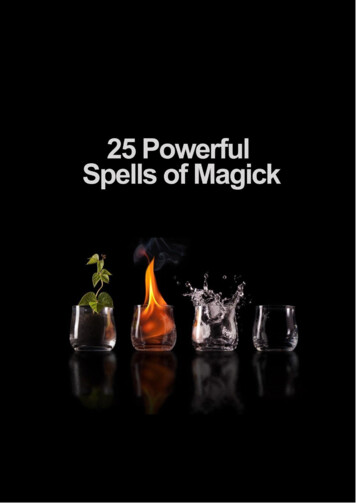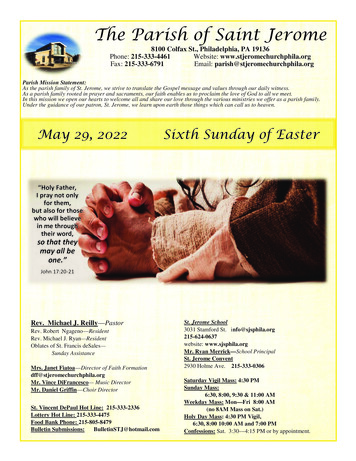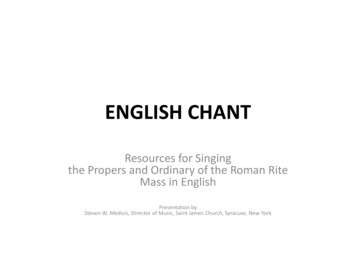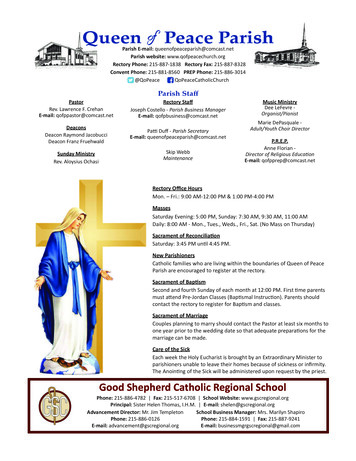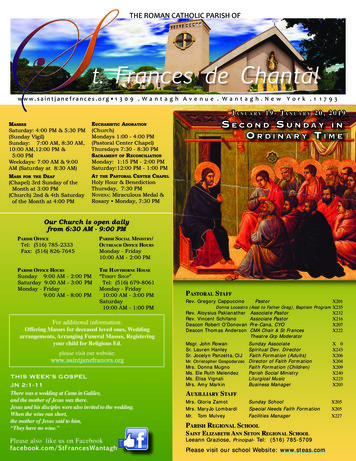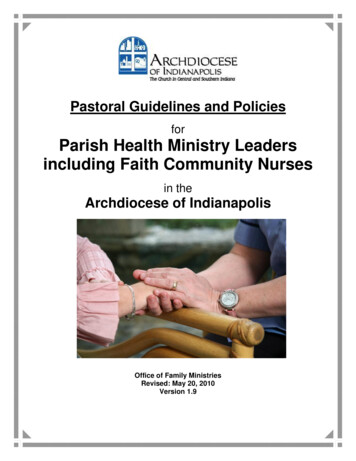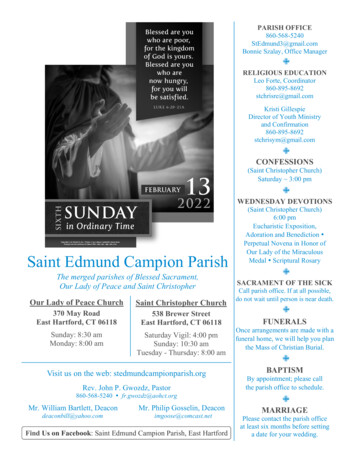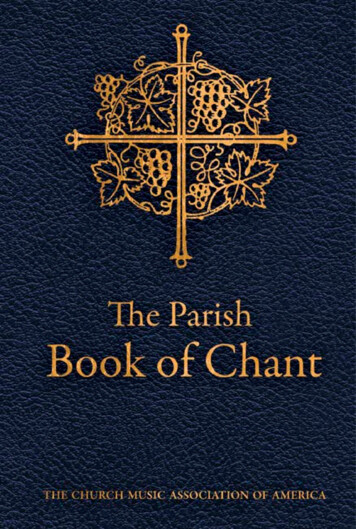
Transcription
The ParishBook of ChantExpanded Second Edition
The ParishBook of ChantExpanded Second EditionA Manual of Gregorian Chantand a Liturgical Resourcefor Scholas and CongregationsincludingOrder of Sung Mass for bothOrdinary and Extraordinary Forms of the Roman Ritewith a complete Kyriale, along withChants and Hymns for Occasional and Seasonal Useand their literal English translationsPrepared for theThe Church Music Association of America
Copyright 2012 CMAACreative Commons Attribution rpts from the English translation of The Roman Missal 2010International Commission on English in the Liturgy Corporation.All rights reserved.
Dedicated to His Holiness, Pope Benedict XVI,in thanksgiving for his motu proprio, Summorum Pontificumand to Msgr. Andrew Wadsworth,Executive Director, ICEL Secretariat, Washington, D.C.
TABLE OF CONTENTSpage no.ORDER OF SUNG MASS, ORDINARY 9.20.21.Introductory Rite. 2Penitential Act . 3Confiteor . 3Miserere nostri. 4Petitions with Kyrie. 5Kyrie, Missa XVI. 5Gloria, Missa VIII . 6Liturgy of the Word . 7Alleluia, simple melody. 8Gospel Acclamation, simple melody . 8Miserere mei, Deus, psalm and response . 8Credo. 10Prayer of the Faithful . 11Kyrie, Response . 11Ut nos exaudire, petition and response . 11Liturgy of the Eucharist. 12Preface Dialogue . 13–14Solemn Tone, Sundays and Feasts . 13Ferial Tone, Weekdays . 13Most Solemn Tone, Solemnities . 14Sanctus, Missa XVIII . 14Eucharistic Prayer I, Roman Canon. 15Memorial Acclamation . 17Eucharistic Prayer II . 19Eucharistic Prayer III. 21Eucharistic Prayer IV. 23Communion Rite . 26Pater noster. 26Agnus Dei, Missa XVIII. 28Concluding Rite. 30Pontifical Blessing. 30Dismissal, Mass XI. 31Dismissal, simple. 31Dismissal, with alleluias . 31ORDER OF SUNG MASS, EXTRAORDINARY FORM22.23.24.25.Asperges me . 34Asperges me, ad libitum I . 35Vidi aquam . 35Mass of the Catechumens . 36Mass of the Faithful . 42Preface Dialogue, Solemn Tone . 45Preface of the Most Holy Trinity, Sundays. 46Common Preface, weekdays . 46Canon of the Mass . 47
viiiThe Parish Book of Chant26.27.Holy Communion .51Prayers After Communion .54Dismissal, Missa XI .55Dismissal, Holy Saturday to Easter Saturday .55Last Gospel .56Prayers After Low Mass .57CHANTS FOR THE ORDINARY OF THE MASSMass I, Lux et origo, in Paschal Time .6028. Kyrie 29. Gloria 30. Sanctus 31. Agnus 32. Ite 33. Ite, AlleluiaMass II, Kyrie fons bonitatis, for Solemn Feasts .6334. Kyrie 35. Gloria 36. Sanctus 37. Agnus 38. Ite 39. Ite, alternateMass III, Kyrie Deus sempiterne, for Feasts.6640. Kyrie 41. Gloria 42. Sanctus 43. AgnusMass IV, Cunctipotens Genitor Deus.6944. Kyrie 45. Gloria 46. Sanctus 47. Agnus 48. IteMass V, Kyrie magnæ Deus potentiæ.7249. Kyrie 50. Gloria 51. Sanctus 52. Agnus 53. IteMass VI, Kyrie Rex Genitor .7554. Kyrie 55. Gloria 56. Sanctus 57. Agnus 58. IteMass VII, Kyrie Rex splendens.7959. Kyrie 60. Gloria 61. Sanctus 62. Agnus 63. IteMass VIII, De Angelis.8264. Kyrie 65. Gloria 66. Sanctus 67. Agnus 68. IteMass IX, Cum jubilo, Feasts of the Blessed Virgin Mary .8569. Kyrie 70. Gloria 71. Sanctus 72. Agnus 73. IteMass X, Alme Pater, Feasts of the Blessed Virgin Mary.8874. Kyrie 75. Gloria 76. Sanctus 77. AgnusMass XI, Orbis factor.9178. Kyrie 79. Gloria 80. Sanctus 81. Agnus 82. IteMass XII, Pater cuncta.9483. Kyrie 84. Gloria 85. Sanctus 86. Agnus 87. IteMass XIII, Stelliferi Conditor orbis.9788. Kyrie 89. Gloria 90. Sanctus 91. Agnus 92. IteMass XIV, Jesu Redemptor. 10093. Kyrie 94. Gloria 95. Sanctus 96. Agnus 97. IteMass XV, Dominator Deus . 10398. Kyrie 99. Gloria 100. Sanctus 101. Agnus 102. IteMass XVI, Weekdays throughout the Year . 106103. Kyrie 104. Gloria 105. Sanctus 106. IteMass XVII, Sundays of Advent and Lent . 107107. Kyrie 108. Gloria 109. Sanctus 110. IteMass XVIII, Deus Genitor, Weekdays of Advent and Lent . 108111. Kyrie 112. Gloria 113. Sanctus 114. Ite115, 116. Dismissal during Advent and Lent, older practice . 109
Table of Contents117.118.119.120.121.122.ixCredo I . 110Credo II. 112Credo III . 114Credo IV . 117Credo V. 119Credo VI . 121Ordinary Chants ad libitum123. Ambrosian Gloria . 124124. Kyrie I, Clemens Rector . 125125. Kyrie II, Summe Deus. 126126. Kyrie III, Rector cosmi pie . 126127. Kyrie IV, Kyrie altissime . 127128. Kyrie V, Conditor Kyrie omnium . 128129. Kyrie VI, Te Christe Rex supplices . 128130. Kyrie VII, Splendor æterne . 129131. Kyrie VIII, Firmator sancte . 130132. Kyrie IX, O Pater excelse. 130133. Kyrie X, [Orbis factor, alt.], Sundays . 130134. Kyrie XI, [Kyrie Salve], Sundays of Advent and Lent . 131135. Gloria I . 131136. Gloria II. 133137. Gloria III . 134138. Sanctus I . 136139. Sanctus II . 136140. Sanctus III. 137141. Agnus Dei I . 137142. Agnus Dei II. 138143. Pater noster, B . 138144. Pater noster, C . 139145. Asperges me, ad libitum, II . 140Settings of the Alleluia. 141Simple: 146. Mode VI 147. Mode II 148. Mode VIIIMelismatic: 149. Mode II 150. Mode IV 151. Mode VIIISEQUENCES152. Victimæ paschali laudes, Easter. 142153. Veni Sancte Spiritus, Pentecost . 143154. Lauda Sion, Corpus Christi. 145MISSA PRO DEFUNCTIS155. Responsory on entering the church, Subvenite . 151156. Introit, Requiem æternam . 152157. Kyrie. 153Collect . 153158. Gradual, Requiem æternam . 153159. Tract, Absolve Domine . 154
xThe Parish Book of Chant160. Sequence, Dies Iræ. 156161. Offertory, Domine Jesu Christe. 160Secret . 162Preface . 162162. Agnus Dei . 162163. Communion, Lux æterna. 163Postcommunion . 163Absolution . 163164. Responsory, Libera me. 164165. Kyrie, before the Pater noster. 165Final Prayer . 166166. In paradisum . 166167. Chorus Angelorum . 166168. Ego sum resurrectio, at Graveside . 166169. Si iniquitates, Antiphon at the Meeting of the Body. 167170. Exultabunt, Antiphon while Entering the Church . 167HYMNS AND CHANTSCommunion Chants ad libitum . 170171. Ego sum vitis vera . 170172. Gustate et videte . 170173. Hoc corpus. 170174. Manducaverunt . 171175. Panem de cælo. 171176. Panis quem ego dedero . 172177. Qui manducat carnem meam. 188.189.190.191.192.193.194.195.196.Hymns and ChantsAdoremus in æternum . 173Adoro te devote . 174Anima Christi . 176Anima Christi, another tune. 177Ave verum Corpus. 178Christus vincit . 179Confirma hoc. 185Cor Jesu sacratissimum . 185Cor Jesu sacratissimum, another tune. 185Da pacem Domine . 186Ecce panis Angelorum . 186Jesu dulcis memoria . 187O panis dulcissime . 189O salutaris Hostia. 191Verbum supernum . 191O salutaris Hostia, another tune . 192Oremus pro Pontifice . 193Pange lingua . 194Tantum ergo . 195
Table of 7.xiPanis angelicus. 196Sacris solemniis. 197Panis angelicus, another tune . 199Sacerdos et Pontifex . 200Te decet laus . 200Te decet laus, another tune. 200Te Deum laudamus, solemn tone . 201Te Deum laudamus, simple tone . 205Veni Creator Spiritus . 208Veni Sancte Spiritus. 210Venite adoremus. 210HYMNS AND CHANTS IN HONOR OF THE BLESSED VIRGIN 9.220.221.222.223.224.225.226.Salve Regina, solemn tone. 211Salve Regina, simple tone . 212Salve Regina, solemn tone, monastic use . 213Alma Redemptoris Mater, solemn tone . 214Alma Redemptoris Mater, simple tone. 216Ave Regina cælorum, solemn tone . 216Ave Regina cælorum, simple tone. 217Regina cæli, solemn tone . 218Regina cæli, simple tone. 219Regina cæli, ad lib. Office antiphon . 219Ave Maria. 220Ave maris stella. 220Inviolata . 222Maria Mater gratiæ . 223O Sanctissima . 224Salve Mater misericordiæ. 224Sub tuum præsidium . 226Tota pulchra es . 226Tota pulchra es, another version (Dom Pothier) . 227SEASONAL HYMNS AND CHANTSAdvent227.228.229.230.Creator alme siderum . 230Conditor alme siderum. 231Rorate cæli desuper . 232Veni, veni Emmanuel . 234Christmas231. Adeste fideles . 237232. Corde natus ex Parentis. 237233. Ecce nomen Domini . 240234. Hodie Christus natus est . 241235. Puer natus in Bethlehem . 241236. Resonet in laudibus . 245237. Salve Virgo singularis . 247
xiiThe Parish Book of ChantEpiphany238. Verbum bonum et suave . 248Candlemas (Feb. 2)239. Lumen ad revelationem, ant. blessing of candles . 249Lent240.241.242.243.Attende Domine. 250Parce Domine . 252Stabat Mater, sequence . 254Stabat Mater, simple tone . 257Palm Sunday244. Hosanna filio David . 261245. Pueri Hebræorum. 261246. Versicle and Response before the Procession. 261247. Gloria, laus et honor . 262Holy Thursday248. Ubi caritas et amor. 264Good Friday249. Ecce lignum . 265250. Ecce lignum, simplified (Graduale Simplex). 265251. Improperia, Responses . 266252. Crucem tuam. 267253. Crux fidelis . 267254. Vexilla Regis . 272Easter255.256.257.258.259.260.261.262.Lumen Christi, at the Easter Vigil . 275Alleluia, at the Easter Vigil. 275Concordi lætitia . 275Exsultemus et lætemur. 277Lapis revolutus est. 279O filii et filiæ . 280Regina cæli jubila . 283Salve festa dies . 284Sacred Heart263. Cor Jesu amantissimum . 287GOSPEL CANTICLES AND LITANY OF SAINTS264.265.266.267.268.269.270.Benedictus, at Lauds . 289Magnificat, at Vespers, solemn tone . 290Magnificat, at Vespers, simple tone. 292Salva nos / Nunc dimittis, at Compline . 293Salva nos / Nunc dimittis, Liber usualis. 294Litany of Saints, Ordinary Form . 295Litany of Saints, Extraordinary Form . 297Complete List of Saints. 303
Table of ContentsxiiiGUIDE TO SINGING CHANT. 305Notes and Groups of Notes . 305Staff and Clef Signs. 306Rhythmic Markings and Expressed Notes . 307Barlines . 309Plainsong Rhythm . 310Repercussions . 311Modal Melodies. 312Table of Neums . 313GUIDE TO PRONOUNCING LITURGICAL LATIN . 314INDEX . 316BENEDICTION OF THE BLESSED SACRAMENT . 320
FOREWORD TO THE SECOND EDITIONAs a composer, I have learned over the years that, as exciting as premiere performances may be, what really matters is a second performance. And while the vast majority of my favorite works await that validating experience, I am no less gratified to see The Parish Book of Chantenter its next phase.This expanded edition is the result of much user feedback (whichpoints to many actual users—gratifying in itself). But it also comes outof personal indulgence, the opportunity not only to correct first-runomissions, but to make the book better. It is, in fact, the book weshould have published in 2008 (which seems an age ago now). I onlyhope that ratty bindings and dog-eared pages, the result of frequentuse, may sufficiently justify replacement copies a mere four years later.Principally, this edition includes all hymn verses fully notated. It includes the Sequences, and all four Eucharistic Prayers for the OrdinaryForm. It provides a complete Kyriale, including all 18 chant Masses, allsix Credos, and all the ad libitum Ordinary chants. To acknowledgegrowing interest in the Mass Propers, it includes the ad libitum Communion chants listed in the Graduale Romanum. For the ExtraordinaryForm, it includes the complete Requiem Mass, as well as the Litany ofSaints for the Easter Vigil in both Forms. All of which makes the booktwice as big, and hopefully several times more useful.The other significant change was compelled by events, and by yetanother significant development in the greater world of liturgy. Thepromulgation of the Third Edition of the Roman Missal in English maynot be as obvious an impetus as Summorum Pontificum was to the original PBC. Nevertheless, like all Catholic hymnographers in the Englishspeaking world, I can hardly ignore the event. It was with utter joy thatI replaced our literal-but-not-for-liturgical-use translation of the Ordinary Form of the Roman Rite with ICEL’s new English translation,which comes so much closer to giving us the Latin verbatim. It is agreat aesthetic improvement, for sure. But I would suggest it also goesa long way toward vindicating the Latin itself, in the ears of the leery,who never quite believed the chant represented their Roman Rite. Asthey absorb the new translation, they will begin to see in the Latin ofthe chant a real and ready reference, and realize that the Church’s liturgy, like her faith, comes from somewhere far beyond any one language, culture, or personality.xv
xviThe Parish Book of ChantWith that in mind, I dedicate the Second Edition of The Parish Bookof Chant to Msgr. Andrew Wadsworth, Executive Director of the ICELSecretariat in Washington, D.C., and a leading architect of the newEnglish translation of the Roman Missal.* * *For this second edition, I am especially indebted to Professor PeterKwasniewski, Wyoming Catholic College, who provided several muchimproved translations and other helpful editorial suggestions. His proficiency in both the music and language of the Latin liturgy never ceasesto amaze and inspire me. Thanks also to Greg Bennett, with his eye fordetail, and Kathy Pluth, always ready with a pertinent comment.— Richard Rice, Editorwww.RiceScores.com
FOREWORD TO THE FIRST EDITIONTherefore if any man be in Christ, he is a new creature:old things are passed away; behold, all things are become new.(2 Cor. 5: 17, KJV)What justifies a new collection of Gregorian chant for today’s Church?Based on the interest and activity generated by organizations such asthe Church Music Association of America, we are witnessing a truerenaissance of traditional music for the Catholic liturgy. Leading theway is Gregorian chant, to which the Second Vatican Council gave“pride of place” among the many forms of liturgical music.This pride of place belongs to chant by its very nature, having beenborn of and for the Church’s liturgy, having served her for a millennium or more, having nourished her saints, catechized her people, comforted those who mourn, given voice to those who rejoice.More than any other form of music, chant fulfills the Council’svision that sacred music “be considered the more holy in proportion asit is more closely connected with the liturgical action, whether it addsdelight to prayer, fosters unity of minds, or confers greater solemnityupon the sacred rites.” To this end, Gregorian chant is “specially suitedto the Roman liturgy.” †With his motu proprio, Summorum Pontificum, Pope Benedict XVI hasgiven new impetus for a re-appropriation of chant in the liturgical lifeof the modern Church. By expanding the use of the traditional form ofthe Roman Rite (now known as the Extraordinary Form), the HolyFather provides for the mutual coexistence of this form, along with itsmodern expression (the Ordinary Form). Beyond mere coexistence,however, he envisions that the proximity of the two forms can be“mutually enriching,” the inherent sacrality of the old influencing thereverent celebration of the new. Constitutive of that sacrality hasalways been the sacred chant.The present collection is offered, then, as a direct response to theHoly Father’s call for this mutual enrichment. We have included theOrder of Mass for both Ordinary and Extraordinary Forms of theRoman Rite, with their musical settings. Rather than reproducing theofficial English version of the modern Roman Rite, we have insteadprovided English translations that render the Latin as faithfully andas elegantly as possible. [This new edition uses the recently publishedEnglish translation of the Roman Missal, Third Edition.] For the Ordinary Form, we have selected Eucharistic Prayer I, the Roman Canon, to†cf. Constitution on the Sacred Liturgy § 112, 116.xvii
xviiiThe Parish Book of Chantshow as clearly as possible the concordance between the two Forms ofMass. [All four EPs are included in the new edition.]Our Order of Mass is necessarily limited to the ordinary (unvarying)texts, and congregations that celebrate Mass in Latin regularly, undereither Form, will need to supplement this collection with the textsproper to each celebration (prayers, readings, prefaces, proper chants).Following the Orders of Mass, we include a dozen settings of theMass Ordinary (Kyrie, Gloria, Sanctus, Agnus Dei), four settings of theCredo, and various other ordinary chants. [The complete Kyriale is included in the new edition.] We have given only minimal directions forspecific uses of the various Mass Ordinaries. Indeed, congregations arefree to choose the settings that best serve their needs, and may evenmix and match movements from a variety of Ordinaries.A collection of about six dozen chants of various styles follows,which are arranged by genre and liturgical season. These chants werecollated from a variety of sources, including Liber Cantualis (Solesmes,1978), Chants of the Church (Gregorian Institute of America, 1953), andseveral traditional hymnals. We hope the selections are extensiveenough to provide for the needs of most congregations, without overwhelming them. Nor have we limited our selections to authentic chant,and have included a few popular Latin hymns (Adeste fideles; O Sanctissima) that work well in the context of sung Latin Mass.In the co
6. Alleluia, simple melody.8 7. Gospel Acclamation, simple melody . Prayer of the Faithful.11 9. Kyrie, Response.11 10. Ut nos exaudire, petition and . I am no less gratified to see The Parish Book of Chant enter its next phase. This expand
